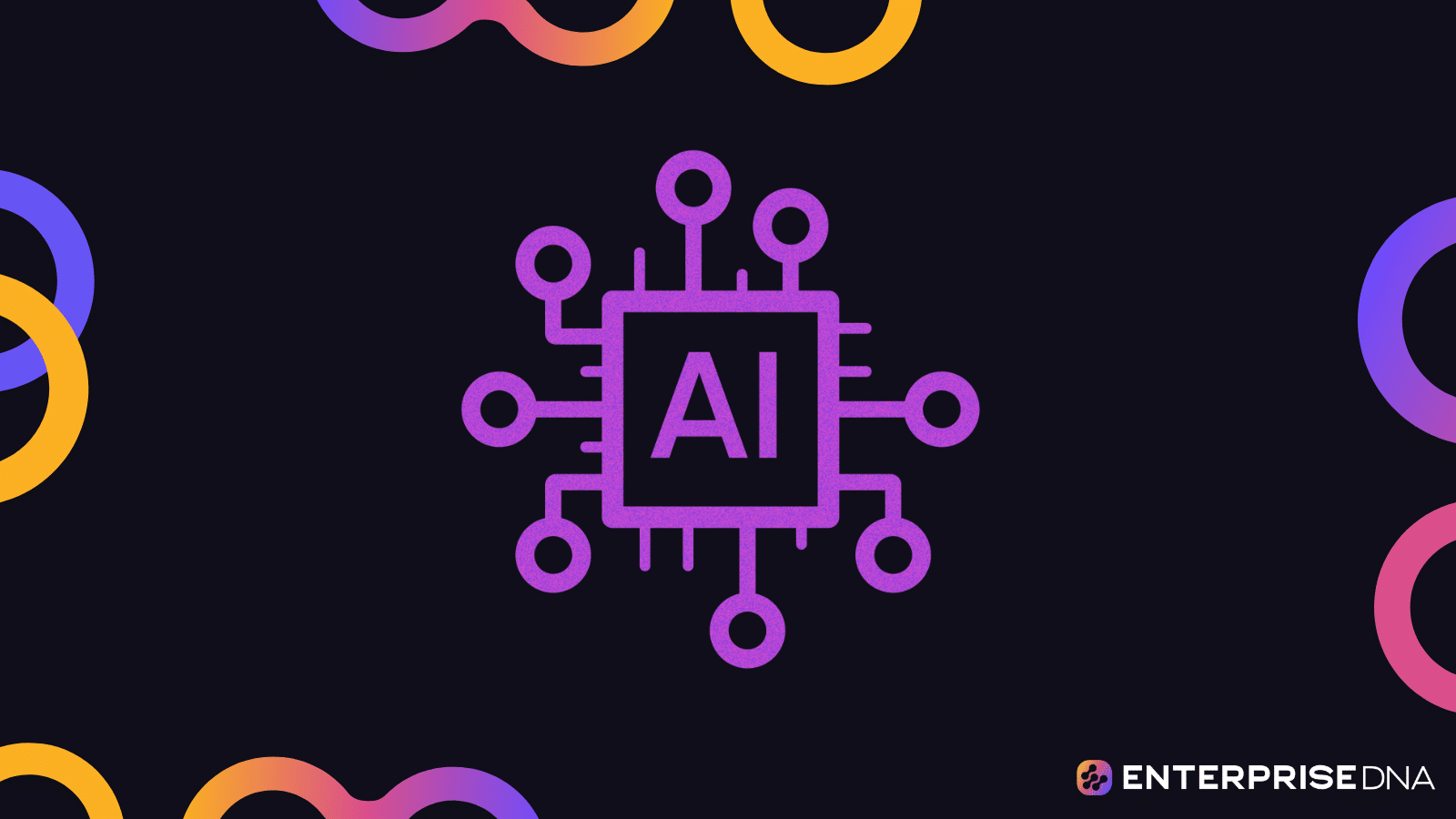As developers, we are always on the lookout for new tools that can improve our coding efficiency and help us maintain high code quality standards.
A code paraphraser is a tool or software designed to rephrase or rewrite code while maintaining its original functionality. It changes the structure and syntax of the code without altering its behavior or the output it produces.
AI-powered code generators are revolutionizing the coding landscape with code paraphrasing!
This can be used for various purposes, such as improving readability, adhering to coding standards, avoiding plagiarism, or simplifying complex code structures.
In this article, we’ll delve into how this technology works, its benefits and drawbacks, and how it transforms how you approach programming.
So, without further ado, let’s unlock the secrets of AI-powered code paraphrasers!
Overview of Code Paraphrasing
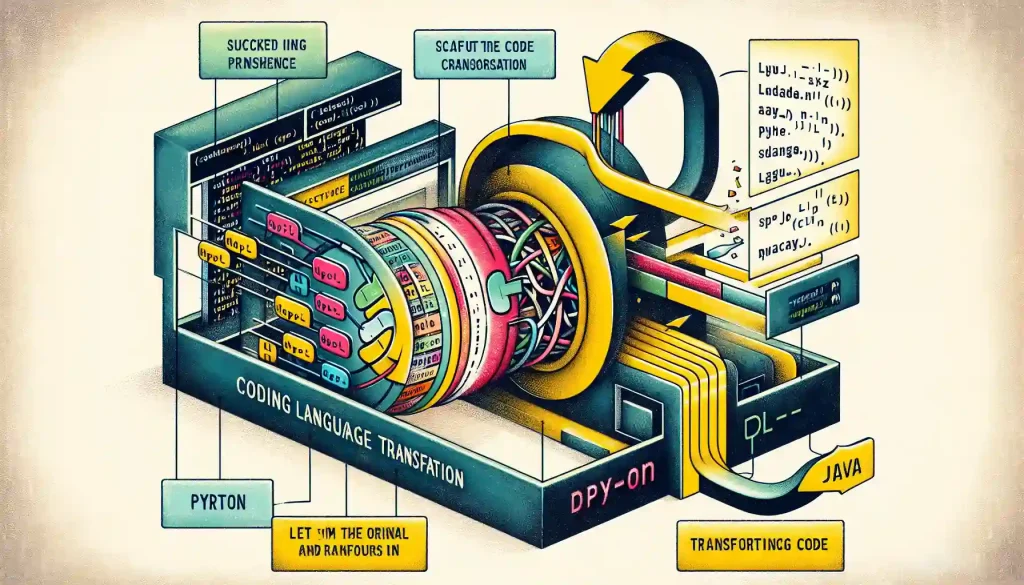
In the ever-evolving world of software development, grasping code through the perspective of Natural Language Processing (NLP) has become an essential method to bolster code quality and maintainability.
The 6 Main Advantages of Using a Code Paraphraser
Improved Readability: Adopting descriptive names for variables and functions, detailed comments, and reorganized sections make scripts more straightforward to read and understand.
Enhanced Maintainability: Scripts that align with best practices and standards are more accessible to upkeep, streamlining future modifications and debugging.
Consistency: Implementing uniform naming and formatting conventions across a project ensures a cohesive and organized structure.
Efficiency Gains: Refactoring scripts to reduce complexity streamlines the code and boosts performance by eliminating redundancies.
Adherence to Standards: Aligning scripts with industry guidelines and coding norms ensures they meet professional and regulatory expectations.
Versatility Across Environments: Refining scripts is adaptable to various programming languages and environments.
By utilizing NLP strategies, developers can enhance their understanding of the codebase, detect patterns and anti-patterns, and address issues more efficiently.
Now, let’s take a deeper look at how to paraphrase code.
How to Paraphrase Code
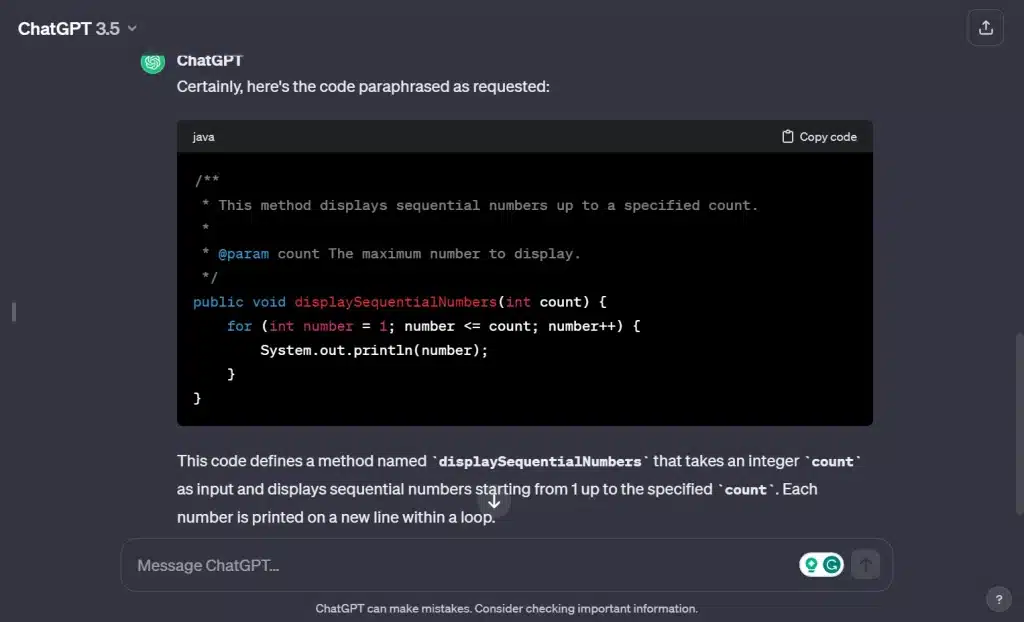
The following examples demonstrate how this technique can transform code with ChatGPT written in different languages into more readable and maintainable versions while preserving their original functionality.
Now, let’s explore examples in different programming languages:
Example 1: Java
User Input: “Rename the method and variables in this Java code to better reflect their purpose.”
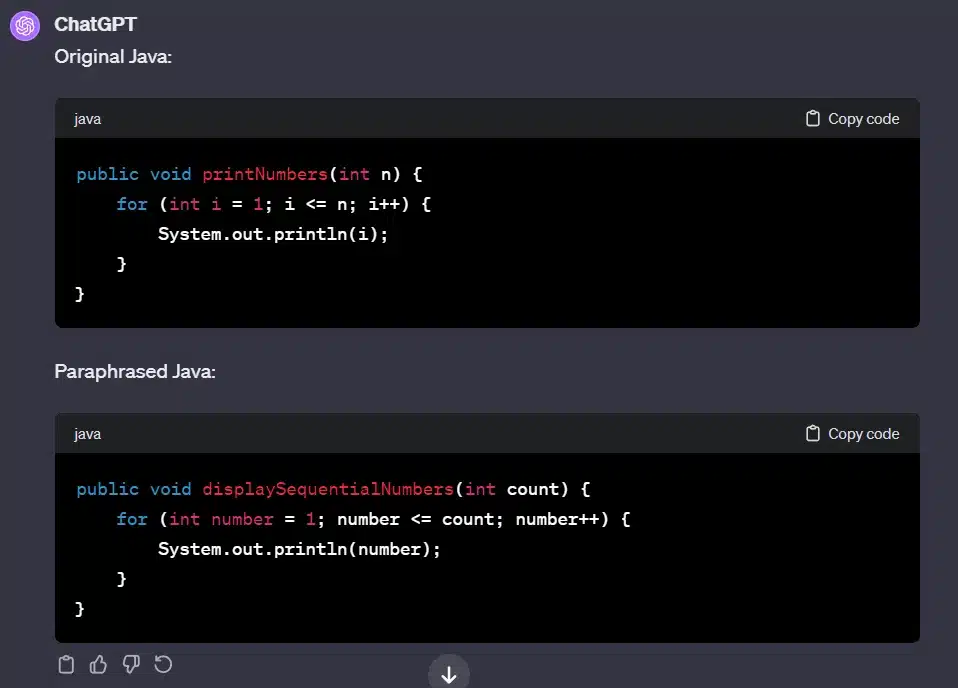
In this example, we’ve renamed to displaySequentialNumbers with parameter count. Inside the loop, i becomes a number representing the current number in the printed sequence.
Next, let’s see how it’s done in Python.
Example 2: Python
User Input: “Rename the function and variables in this Python code to make it clear that it calculates the mean of a list of values.”
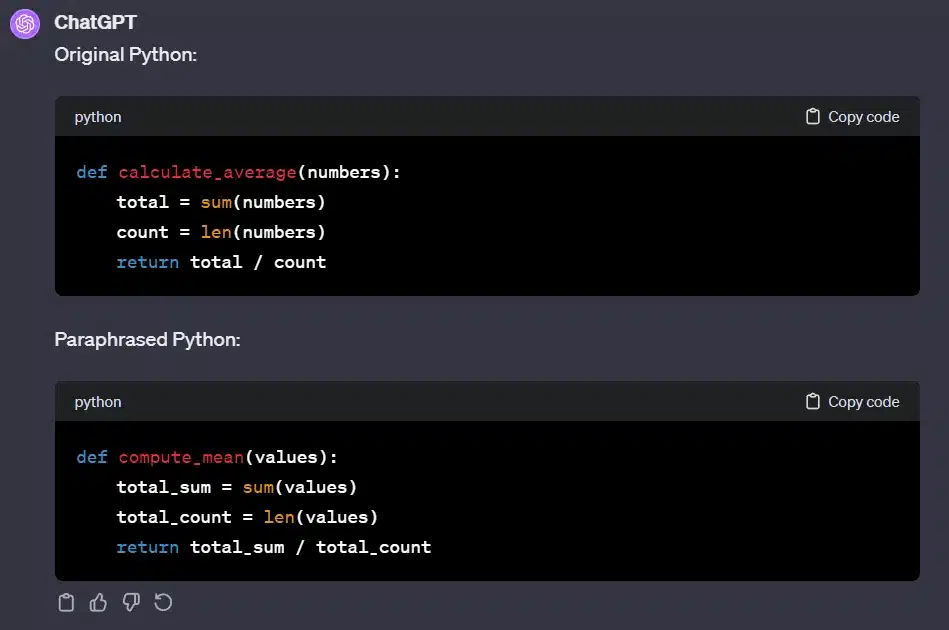
Here, we’ve changed the function name to compute_mean for precision. The total and count variables are now total_sum and total_count, explicitly describing their roles in the mean calculation process.
Now, let’s check out how to do it in JS.
Example 3: JavaScript
User Input: “Rename variable names in this JavaScript code to be more descriptive of their role in validating an email address.“

In the paraphrased version, validateEmail is renamed to isEmailValid for clearer intent, and the email is changed to inputEmail for more precise naming.
Alright, let’s see how it’s done with C++
Example 4: C++
User Input: “Modify this C++ function’s name and parameter to indicate that it squares a given number.”
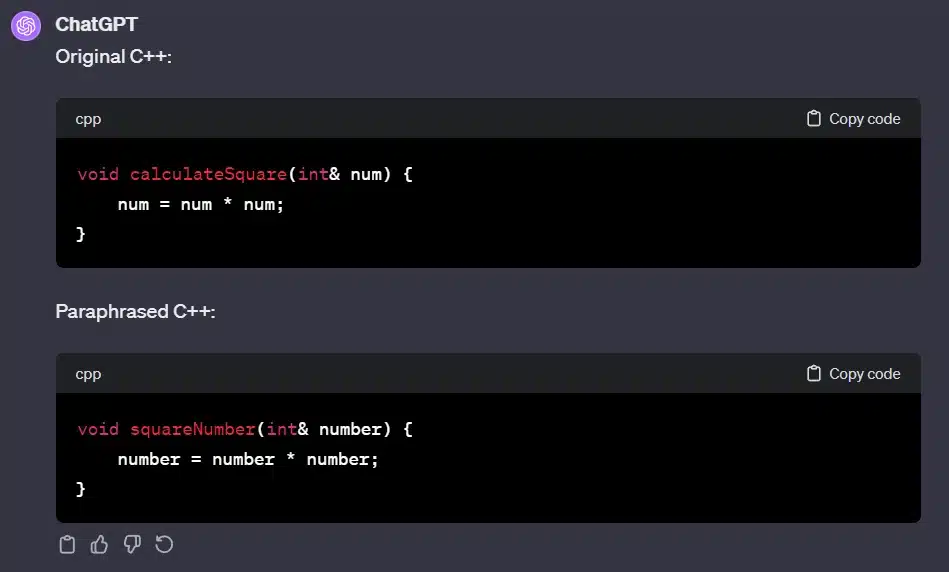
These modifications enhance readability by making the function’s name more descriptive of its action (squaring a number) and the parameter name more explicit.
The core functionality, which is to square the value of the given parameter, remains the same.
For out final example, we’ll paraphrase the ruby code.
Example 5: Ruby
User Input: “Adjust the method name and variable names in this Ruby code to better describe its function in generating a Fibonacci sequence.”
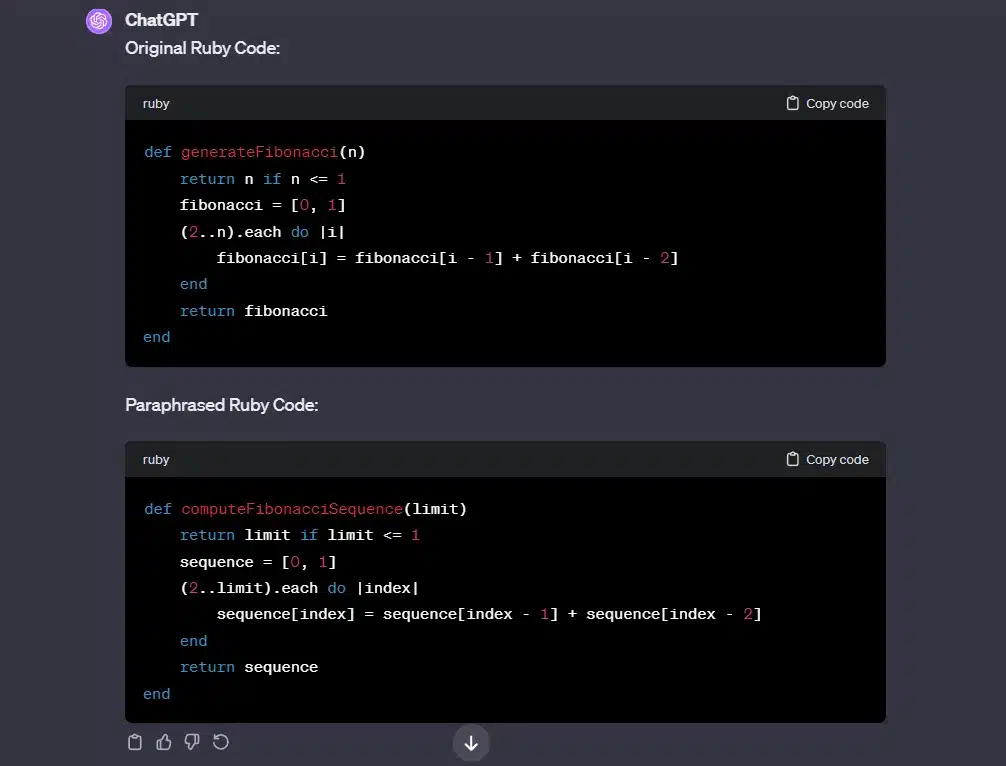
In this example, the original Ruby function generateFibonacci was renamed to computeFibonacciSequence. The parameter n was changed to limit, and the Fibonacci variable was renamed sequence.
These changes improve the clarity of the function’s purpose and the role of its variables. The core logic, generating a Fibonacci sequence up to a specified number, remains unchanged.
These examples show how a code paraphrasing tool can improve your code by adjusting variable and function names while preserving the original logic.
Finally, let’s reflect on some of the main points.
Final Thoughts

Transforming or rewriting code is crucial in software development for enhancing readability, maintainability, and efficiency, ensuring code adheres to set standards.
Also, this practice is essential for producing functional and collaborative-friendly code.
The introduction of AI-driven tools to generate paraphrases has significantly impacted the coding and programming sectors.
Furthermore, these advancements have streamlined development processes and elevated code quality.
As this technology advances, it promises further innovations that could revolutionize software engineering, pointing to a future where code transformation plays a key role.
With the ongoing evolution of AI in code transformation, developers should integrate these tools into their workflow to stay ahead in the fast-paced technology sector.
Improve your M code writing and debugging skills with this concise guide on the enterprise DNA YouTube channel:
Frequently Asked Questions
What is the Purpose of Rephrasing Code?
This process involves rewording and restructuring software code to maintain its original function. It enhances code clarity and compliance with coding standards, crucial for individual and collaborative software development.
How Can Paraphrase Tools Enhance Code Writing?
Paraphrase tools assist developers in rewording code sentences, enhancing their understanding, and making the code more accessible to others. This is particularly beneficial in collaborative environments.
Is This Technique Specific to Certain Programming Languages?
No, this technique is universally applicable across various programming languages and development environments. Its versatility makes it an essential practice for diverse coding projects.
Does Rewriting Code Alter? It’s the way it works?
The primary aim is to keep the original functionality intact. The focus is reorganizing the code, renaming elements, and improving documentation without modifying the underlying logic.
Are There Automated Tools for This Process?
Yes, developers can access refactoring tools and integrated development environment (IDE) features to assist in this process. The advent of AI-driven tools offers additional support by automating code improvements.
Can Legacy Code Benefit from This Practice?
Absolutely. Applying these techniques to your original code can revitalize and enhance its readability and maintenance, making it more compatible with contemporary development practices.
Does This Practice Supersede Manual Review?
While automated tools provide significant aid, manual code review and refactoring remain indispensable. Human expertise is crucial for intricate code analysis and making nuanced decisions.
How Do Developers Ensure the Security of Rephrased Code?
When rephrasing code, developers must consider the security implications. They should ensure that the rephrased code does not introduce vulnerabilities and maintains the original code’s security standards.
What is the Role of Data Models in Code Rephrasing?
Data models play a crucial role in code rephrasing. They provide a structured approach to understanding the code, aiding in efficient and effective rephrasing.

